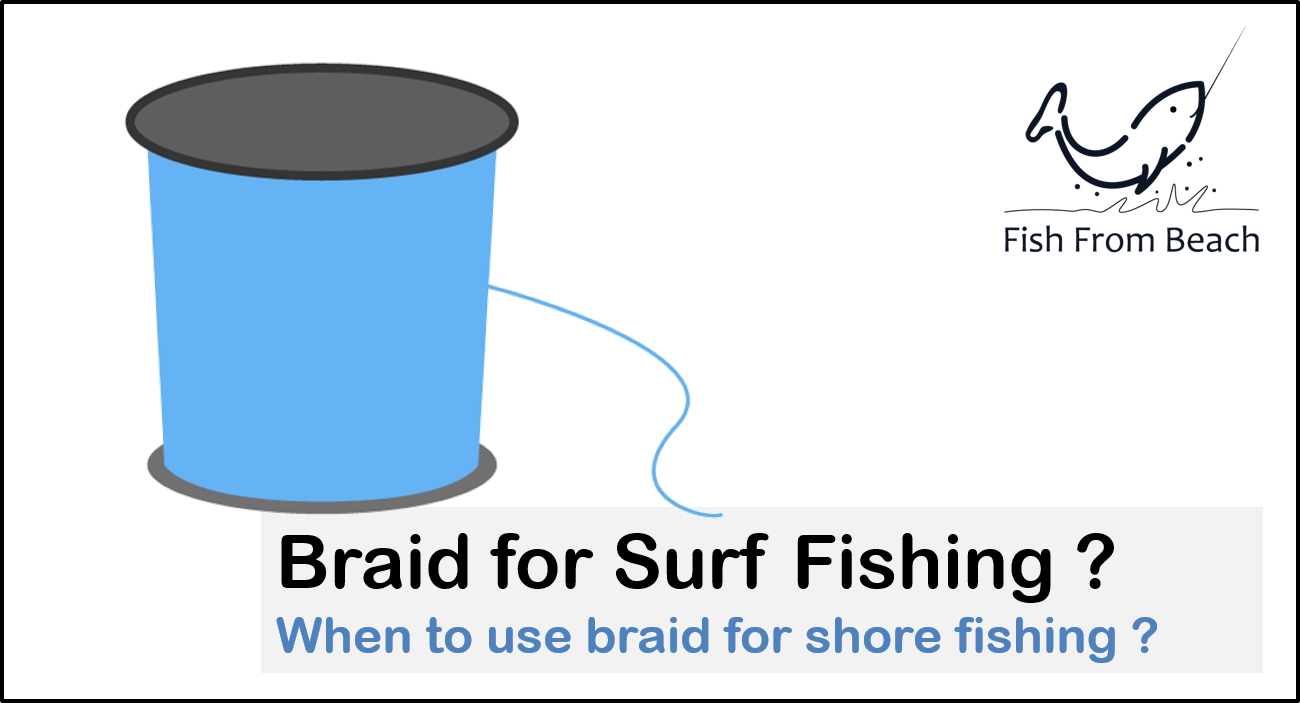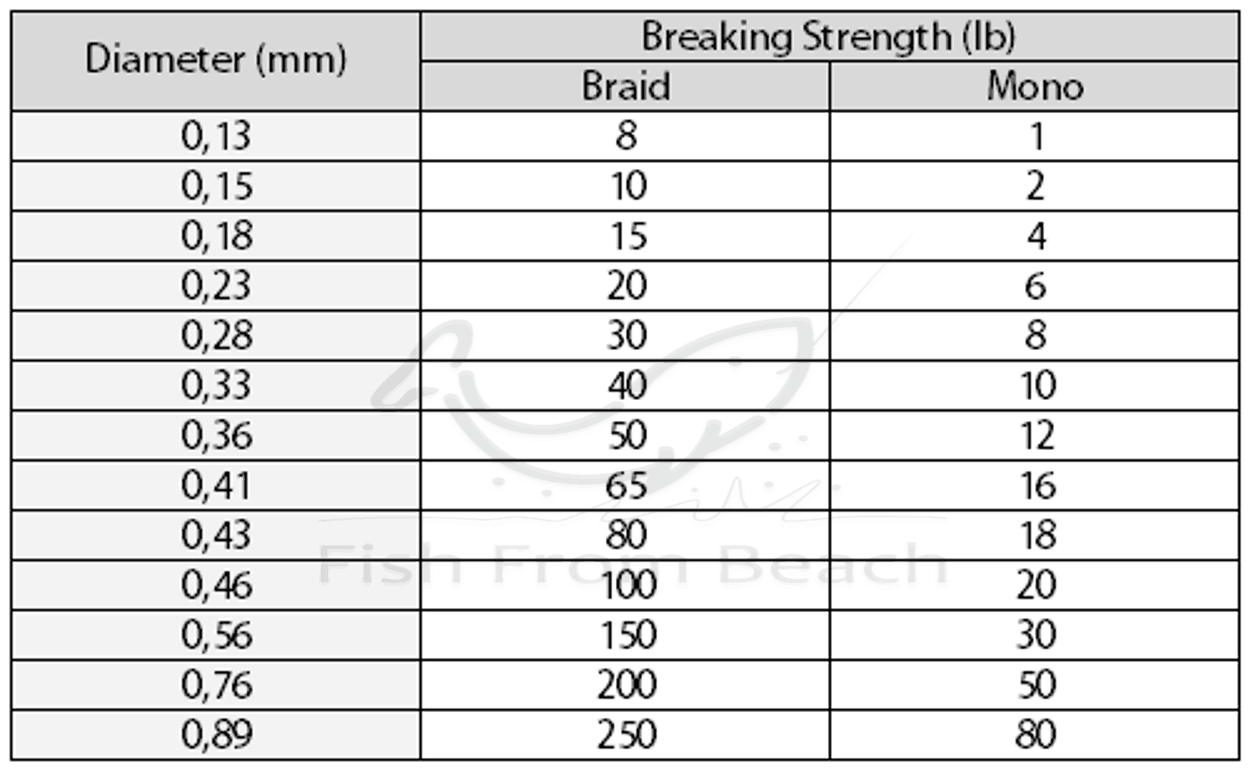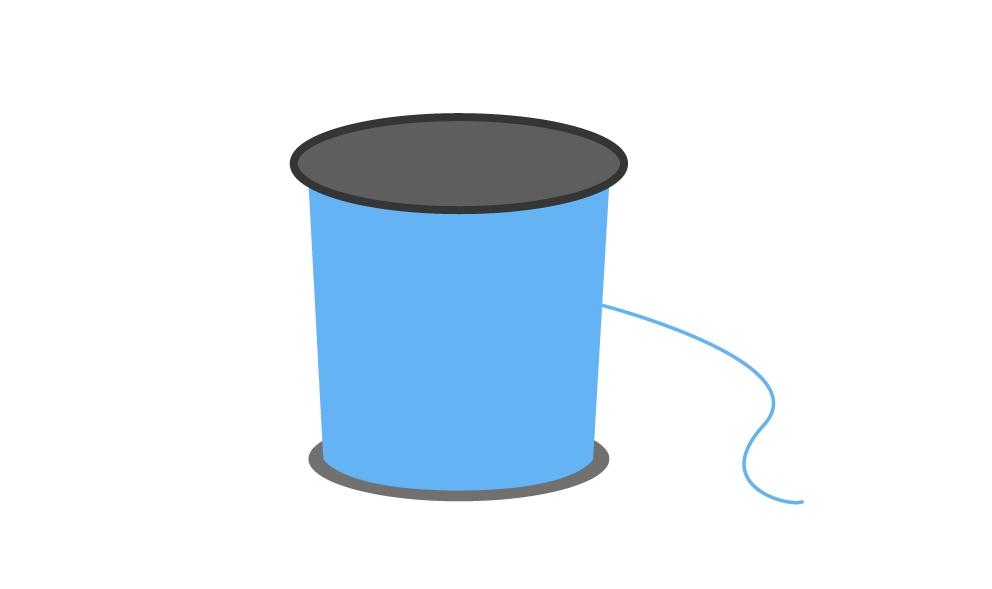
Nowadays, braid is arguably the most used type of line for surf fishing.
Its lack of stretch and high sensitivity makes it the way to go for many surf anglers who want more control over fish, better bite detection, and improved hooksets.
That said, one should be aware that braid comes also with some disadvantages and drawbacks, which sometimes makes it a poor choice for shore fishing.
That’s what this article is all about…
We will discuss when we should use braid for surf fishing ? What are the suitable conditions for braid ? And also, when braided lines become a bad choice for inshore fishing ?
When to use braid for surf fishing ?
When fishing for large fish
The most important feature of braided lines is their high pound test for a given diameter.
In other words, you can use up to 80 lb test of braid and still have the same diameter as an 18 lb test monofilament line.

This is a big advantage when targeting large fish. Why ? Because you will be able to use a high breaking strength which transforms big fish safely without compromising the diameter of your line, which, in turn, has a big impact on your stability in the surf zone and your ability to keep your bait where the fish are most likely to bite.
When using mono for large predatory fish such as sharks, tarpon or snook, you will have to climb in the line thickness scale in order to have the breaking strain necessary to deal with the massive pressure that these monsters exert on the line.
Yes, this will prevent your line from breaking off, but it will also hurt your stability in the surf zone as the wind and surf will put more pressure on your terminal tackle pulling it out of where it should be.
With braid, and with an appropriate casting weight, you generally wouldn’t worry about that. Why ? Because braid will offer you the necessary pound test while keeping your line thin to resist withstand the wind and current.
When fishing for small fish
Yes, I may seem contradictory here, but braid will also help to better detect bites when targeting small fish from shore.
Fish weighing less than 2 pounds generally exert very gentle pressure on the line when striking baits. As a result, you will find it difficult to detect the bite, especially when the wind and waves keep bounding your rod tip.
This is where braided lines come into play and show off their qualities.
Braid is highly sensitive, consequently, when a small fish hit your bait, the line will effectively transmit the vibrations from the other end of the line up to your hands, giving you clear signals that it’s a fish tugging on your offering and it’s time to strike.
Mono and fluoro are less sensitive and less effective at transmitting vibrations along the line. As a result, you will receive less feedback from the surf when a small fish subtly pulls your hook.
When you need distance
Braid is definitely the way to go if you want to reach a greater casting distance.
The low diameter of braided lines make them receive less resistance from air and wind, as a result, they travel more during a cast before dropping into the water.
In addition, when using braid, you will be able to fit more line into the reel and this helps a lot when aiming for distance.
The more the reel is filled, the faster it releases the line, the further you will be able to reach.
Another reason why braided lines offer a greater casting distance is their low memory.
In other words, braided lines do not change in form and retain their original shape even after months of use. This helps a lot when targeting far spots as the line will smoothly leave the rod and thus go further in the surf.
Conversely, mono has a better memory and takes a curly form after a few weeks of use. As a result, during the load, the line hits more often the rod’s guides reducing the casting distance.
When fishing in choppy surf conditions
As mentioned earlier, the low diameter of braid will not only take your bait further, but it will also allow you to remain stable in a moving surf zone.
As braid is generally thin, it will cut better in the water preventing the current from pulling your baited rig out of where you want it to be.
Similarly, when the wind is blowing off, a braided line will receive less pressure from the air, and thus, your bait will remain stable where the fish are most likely to feed.
That said, keep in mind that a low diameter is not enough to remain stable in the surf. You still need to use a casting weight to stabilize your baited rig.
Generally speaking, 4-6 oz leads will do great in most surf conditions, but you can use more or less than that depending on the fishing conditions
Read more about this topic in this article.
One last benefit of the low diameter of braided lines is that it allows them to sink better and reach the bottom more quickly. This can be a big advantage, especially when targeting bottom-feeding fish like the flounder or the redfish and when you want to reach the bottom faster to prevent the current from diverting your bait away from the strike zone.
When it’s hard to detect bites
Detecting baits is generally an easy task when fishing from shore. However, during windy weather and rough surf conditions, it may be difficult to distinguish real bites from the wave/wind effect.
In such conditions, as the rod keeps bouncing all the time, you will have a hard time telling when a fish is striking the bait. This will result in retrieving the line too early or too late and lead to many missed catches.
Braid may help with this because, as said before, it’s highly sensitive and very effective at transmitting vibes along the line. As a result, when a fish hits the bait, you will be able to detect strange vibrations very different from what the wind and surf used to create.
Monofilament and fluorocarbon are less sensitive and have reduced vibe transmitting capacities, therefore they make it hard to feel bites during difficult fishing conditions.
Read this article for more tips on how to detect bites when surfcasting.
When using a slow action rod
A rod that bends a lot when exposed to pressure makes hooksets and fighting fish difficult. Why ? Because by bending, it absorbs most of the energy you give to the line, and thus, you will get a weak and late response to any motion you perform in order to set the hook or turn the fish.
This gives a lot of control to the fish and will make you spend more time and energy to drag it inshore.
Generally speaking, soft-tipped rods are not recommended for surf fishing. But, if it’s all you have and you don’t want to invest in a firmer rod, then at least make sure to use a braided line.
The braid’s lack of stretch will compensate for the softness of the rod improving your hook setting and control over fish.
A slow rod with a monofilament line is a terrible combination for surf fishing because they will both absorb all your energy, and that gives a lot of power and leverage to the fish and makes you more reactive to their movements rather than proactive.
Read this article for more information about the optimal speed for surf rods.
When to never use braid for surf fishing ?
Do not use braid when you are a beginner
Braid requires a learning curve before using it because it is less tolerant of mistakes and wrong moves.
The high sensitivity of braided lines, as well as their low stretching capacity, transform hook setting and fighting fish into more challenging tasks.
Let me explain…
When trying to hookset or turn a biting fish, you need to exert a pressure high enough to not let the fish get away with the line, but not that high so you do not rip the hook off its mouth.
Maintaining this pressure with a line that does not stretch is not so obvious because any wrong move can cost you the fish or, more tragically, all your equipment.
You will only learn how much force you need to give to the rod when you accumulate some experience and a lot of trials and errors.
Until that, and if you are just starting out, it is better to stick to monofilament because its stretching capacity will give you a wider error margin where you can make more mistakes while remaining perfectly fine.
On top of that, the lack of stretch of braid makes it require special knots
These knots are harder to tie and need some time to learn.
Using standard knots for the braid may be fine, but it can also create weak spots in your setup that can snap at any moment if you get snagged or if a heavy fish takes the bait.
Braid is not good for abrasion
One of the most known pitfalls of braided lines is their terrible abrasion resistance.
When exposed to abrasion, braid snaps easily making it a bad choice for structure fishing or when targeting sharp-toothed fish like the bluefish, the Spanish mackerel, or the sharks.
Connecting an 18-25 inches monofilament or fluorocarbon leader to your main line is a good fix to that.
Mono and fluoro are better abrasion resistants, therefore, they will help to minimize the break-off risk by keeping your braid away from sharp teeth and rocks.
Do not use braid when you fish clear waters
Braided lines are more visible in water than mono and fluoro. Therefore, it is better to avoid braid when the surf is clear. Why ? Obviously, because fish will see the line and know that something is going wrong (or unfishy :D)
Nice weather days with clear skies and calm surf are therefore the wrong days to try braid for surf fishing since your presentation of bait will not be so appealing to fish and thus they will go off the bite.
However, if you still want to use braid in such conditions, try to connect a mono or fluoro leader to your main line because they are less visible than braid.
This will improve the presentation of your bait and encourage the fish to strike your offering.
Some recommended braided lines for surf fishing (*)
Note (*): If you make a purchase through links from this website, we may get a small share of the sale from Amazon or other similar affiliate programs.
Surf Fishing Survey
Help us provide you with better content by answering simple questions about your surf fishing experience and knowledge.
We will put the collected responses together and turn them into valuable information that will help you catch more fish from shore 😉
Note: No personal information will be collected with your answer.


